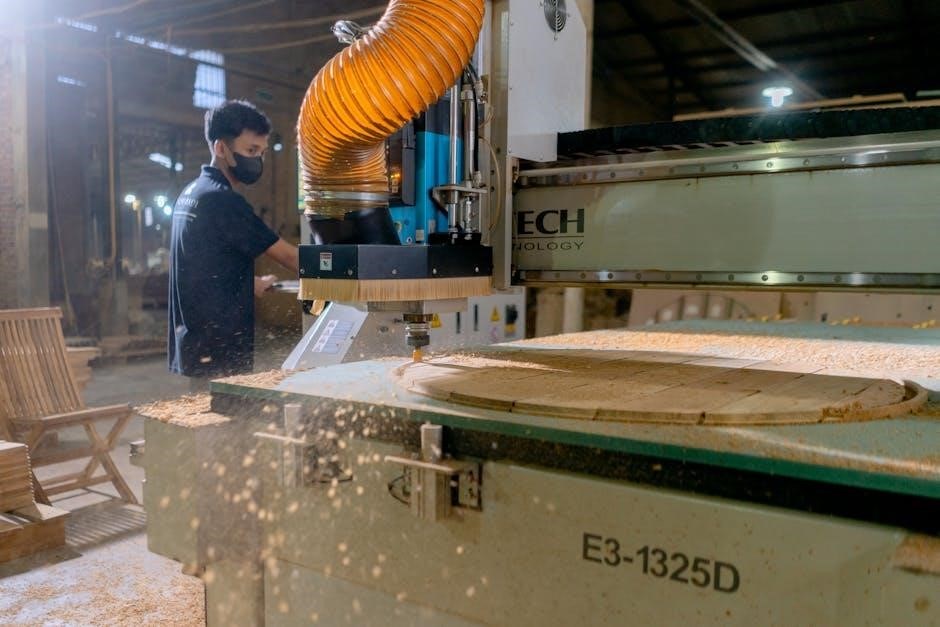FANUC CNC programming is a fundamental language for controlling machine tools, essential for modern manufacturing. It utilizes G-codes and M-codes to execute precise machining operations. PDF guides provide detailed insights and practical examples, helping programmers master FANUC-specific techniques and optimize production processes efficiently.

What is FANUC CNC Programming?
FANUC CNC programming is a specialized language for controlling machine tools, using G-codes for movement and M-codes for machine functions. It enables precise machining operations, such as rapid positioning and linear interpolation. PDF guides offer detailed explanations, code examples, and practical applications, making it easier for programmers to learn and implement FANUC-specific techniques effectively.
Importance of FANUC CNC Programming in Modern Manufacturing
FANUC CNC programming is crucial for modern manufacturing, enabling precise control of machine tools and optimizing production processes. It streamlines operations, enhances accuracy, and supports complex machining tasks. By standardizing G-codes and M-codes, it ensures consistency across industries, from aerospace to automotive. Its adaptability and reliability make it indispensable for achieving high-quality outputs and maintaining competitive edge in manufacturing, while reducing errors and downtime.
Key Features of FANUC CNC Controllers
FANUC CNC controllers offer advanced features like high-speed processing, multi-axis control, and real-time data monitoring. They support complex G-code and M-code execution, enabling precise machining. The controllers integrate seamlessly with servo motors and I/O modules, ensuring efficient operation. Enhanced security and user-friendly interfaces further improve productivity. Their robust design and compatibility with various machine tools make them a reliable choice for modern manufacturing, ensuring accuracy and efficiency in diverse applications.

G-Codes in FANUC CNC Programming
G-codes are essential commands in FANUC CNC programming, directing precise machine movements like rapid positioning and linear interpolation. They are fundamental for executing complex machining operations efficiently and accurately.
Understanding G-Codes and Their Functions
G-codes are standardized commands in CNC programming that instruct machine tools to perform specific operations. They control movements, such as rapid positioning (G00) and linear interpolation (G01). Each G-code serves a unique function, from basic positioning to complex tasks like helical interpolation. Understanding these codes is crucial for efficient programming and achieving precise machining results in FANUC systems.
Common G-Codes Used in FANUC CNC Machines
FANUC CNC machines rely on essential G-codes for everyday operations. G00 executes rapid positioning, while G01 performs linear interpolation. G02 and G03 handle circular interpolation in clockwise and counterclockwise directions. G28 returns to the reference position, and G54 selects coordinate systems. These codes are fundamental for milling and turning operations, ensuring precise control over machine movements and tool operations.
Advanced G-Code Functions for Complex Machining
Advanced G-codes like G76 enable precise thread cutting, while G68.2 facilitates helical interpolation for complex contours. G92 is used for tool length compensation, enhancing accuracy. These functions, along with others, allow for intricate machining operations such as peck drilling and grooving. They are essential for achieving high-precision results in demanding applications, making FANUC CNC programming versatile for advanced manufacturing needs and ensuring optimal performance in complex production scenarios.

M-Codes and Their Applications
M-Codes control machine functions like spindle, coolant, and tool changes, essential for operations beyond movement. They enable precise control, ensuring efficient and accurate production processes in CNC machining.
M-codes are auxiliary instructions in CNC programming, controlling non-movement functions like spindle start/stop, coolant activation, and tool changes. They are essential for managing machine states, ensuring precise operations. FANUC-specific M-codes optimize production efficiency and part accuracy, making them indispensable in complex machining. Proper implementation of M-codes streamlines manufacturing processes, reducing downtime and enhancing overall productivity in CNC environments.
Common M-Codes Used in FANUC CNC Programming
Common M-codes in FANUC CNC include M00 (program stop), M03/M04 (spindle clockwise/counterclockwise), and M06 (tool change). M08/M09 control coolant, while M30 ends the program. These codes are fundamental for managing machine operations, ensuring efficient and precise manufacturing processes. Their proper use is crucial for optimal production, part accuracy, and machinery safety, making them essential in FANUC CNC programming guides and resources.
Practical Examples of M-Code Implementation
A typical M-code example involves spindle control and tool changes. For instance, M03 S1200 starts the spindle clockwise at 1200 RPM, while M08 activates coolant. M06 T02 changes the tool to T02, and M09 turns off coolant. M30 ends the program and returns to the start. These codes are often combined with G-codes, such as G00 for rapid positioning, to create complete machining cycles. Practical examples in PDF guides demonstrate real-world applications.
CNC Programming Techniques
Mastering FANUC CNC programming involves understanding G-codes, M-codes, and macro functions. Techniques include efficient toolpath planning, optimized feed rates, and precision positioning. Simulation tools aid in verifying programs, while best practices ensure error-free execution. PDF guides provide detailed examples and troubleshooting tips, helping programmers refine their skills and adapt to complex machining challenges effectively.
Best Practices for Writing Efficient CNC Programs
Efficient FANUC CNC programming begins with understanding G-codes and M-codes. Use simulation tools to verify programs and ensure precision. Always format codes clearly and test programs step-by-step. Properly organize code with comments for readability. Utilize established templates to minimize errors. Optimize feed rates and toolpaths for material efficiency. Regularly review and update programs based on machine performance. Refer to PDF guides for advanced techniques and troubleshooting tips to enhance programming skills and productivity.
Macro Programming and Custom Macros in FANUC
Macro programming in FANUC enables custom functions beyond standard G-codes. It allows programmers to define variables and create complex operations tailored to specific tasks. Macros streamline repetitive processes, such as calculations and tool offsets, improving efficiency. FANUC’s macro language supports conditional statements and loops, offering flexibility. PDF guides detail advanced techniques, while practical examples, like thread cutting cycles, demonstrate macro applications. Proper macro implementation enhances productivity and precision in CNC machining.
Tips for Debugging and Optimizing CNC Code
Debugging CNC code involves reviewing each line for syntax errors and logical flaws. Use simulation tools to visualize program execution and identify issues early. Optimize by reducing unnecessary movements and streamslining commands. Test small sections before full execution to ensure accuracy. Regularly update FANUC software for improved functionality. Referencing PDF guides and manufacturer resources helps resolve common issues efficiently, ensuring smooth and error-free machining operations.

CNC Simulation and Verification
CNC simulation allows visualization of G-code programs, enabling error detection and optimization. Verification ensures precise machining, reducing material waste and enhancing workshop safety.
Using CNC Simulators for G-Code Verification
CNC simulators like NC Viewer and EMCO WinNC allow programmers to visualize and test G-code programs. These tools simulate machining operations, enabling detection of errors and optimization of code. They support Fanuc-specific G-codes, ensuring accurate representation of machining processes. Simulation helps verify program logic, reducing risks during actual production. This step is crucial for ensuring precision, safety, and efficiency in CNC manufacturing operations.
Benefits of Simulation in CNC Programming
Simulation in CNC programming offers numerous advantages, including error detection, reduced material waste, and improved safety. By testing G-code programs virtually, programmers can identify and correct issues before machining. This ensures precise and efficient production, minimizing downtime and costs. Simulation also aids in training and visualizing complex operations, making it an invaluable tool for both novice and experienced CNC programmers working with FANUC systems.
Popular Simulation Software for FANUC CNC
Leading simulation tools like NC Viewer and EMCO WinNC are widely used for FANUC CNC programming. These software solutions emulate machine behavior, allowing precise G-code verification. They support complex operations and offer detailed visualization, enhancing programming accuracy. These tools are essential for optimizing FANUC CNC programs, ensuring error-free machining and efficient production processes in manufacturing environments.
Resources and References
Premium PDF guides and manuals provide in-depth knowledge of FANUC CNC programming, while online courses and tutorials offer practical training. Communities and forums also share valuable insights and expertise.
Recommended PDF Guides for FANUC CNC Programming
Comprehensive PDF guides like the “manual_guide_i” and “CNC Programming Manual” provide detailed insights into FANUC CNC codes. These resources cover G-codes, M-codes, and advanced techniques, offering practical examples and troubleshooting tips. They are ideal for both beginners and experienced programmers, ensuring mastery of FANUC-specific functions. Downloadable in PDF or Excel formats, these guides are essential for enhancing programming skills and optimizing machining processes efficiently.
Online Courses and Tutorials for Advanced Learning
Online platforms offer in-depth courses and tutorials for mastering FANUC CNC programming. Resources like “CNC Programming PDFs” and “EMCO WinNC for Fanuc 31i” provide hands-on training without prior ISO programming knowledge. These courses cover advanced topics, including macro programming and simulation tools, with practical examples to enhance learning. They are ideal for both beginners and experienced programmers, ensuring skill enhancement and alignment with industry standards and emerging trends in CNC technology.
Communities and Forums for CNC Enthusiasts
CNC enthusiasts can engage with active communities and forums, such as CNC-Keller.de, to discuss FANUC CNC programming. These platforms offer valuable resources, including G-code simulations and practical examples. Members share knowledge, troubleshoot issues, and explore advanced techniques. Such communities are essential for networking and staying updated on the latest trends and tools in CNC programming, fostering collaboration and continuous learning among professionals and hobbyists alike.
Mastery of FANUC CNC codes enhances precision and efficiency in manufacturing. As technology evolves, emerging trends like AI and IoT integration will shape the future of CNC programming, ensuring continuous innovation and optimization in the industry.
FANUC CNC programming revolves around G-codes and M-codes, enabling precise machine control. Key concepts include G-code functions like G00, G01, and G76 for positioning, linear interpolation, and threading. M-codes manage auxiliary functions such as spindle control and tool changes. Macro programming enhances customization, while simulation tools optimize code verification. Understanding these elements is crucial for efficient and accurate CNC machining, ensuring high-quality production in modern manufacturing environments.
Emerging Trends in CNC Technology
Emerging trends in CNC technology include advancements in AI-driven machining, enabling predictive maintenance and optimized toolpaths. Collaborative robots (cobots) enhance human-machine interaction, while IoT connectivity allows real-time monitoring and data analytics. Cloud-based CNC programming improves accessibility and collaboration. Additive manufacturing integration with CNC systems is expanding, offering hybrid solutions. Energy-efficient CNC systems and sustainable practices are also gaining traction, ensuring future-ready manufacturing processes that are both productive and environmentally conscious.
Final Thoughts on Mastering FANUC CNC Codes
Mastering FANUC CNC codes requires dedication, continuous learning, and hands-on practice. Understanding G-codes, M-codes, and macro programming is crucial for creating efficient programs. Utilizing simulation tools and PDF guides can enhance skill development. Staying updated with emerging trends like AI and IoT integration ensures adaptability in modern manufacturing. Practical experience and troubleshooting are key to refining expertise, enabling programmers to optimize production and achieve precision in complex machining tasks.
